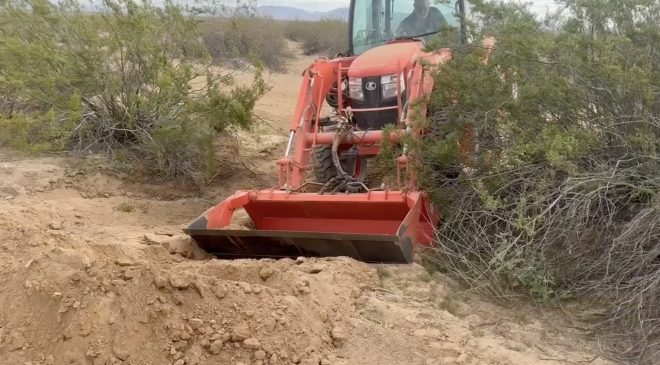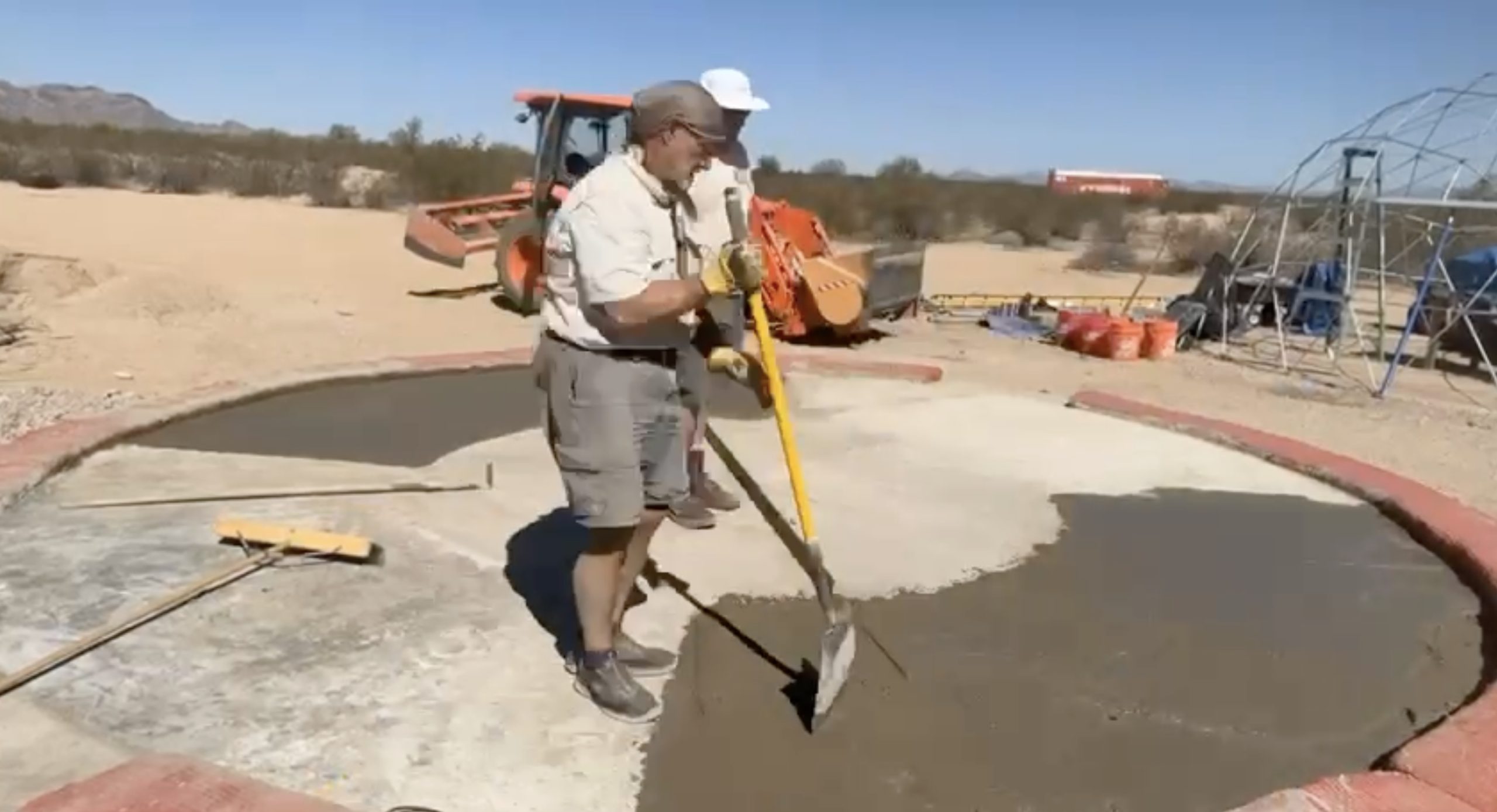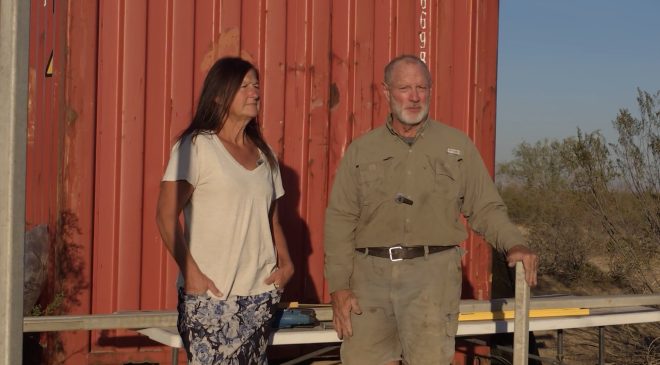
Potato Patch & Container Shuffle: Rainy Day Desert Moves!
In this episode of Occupy the Land, we seize a

In this episode of Occupy the Land, we dive into a busy morning on our Arizona desert homestead! We prep for another concrete pour and lay a new layer of earthbags around our utility dome, focusing on reinforcing doorframes with cement-heavy mixes for durability. Meanwhile, Donna tackles laundry on our clothesline, where the desert heat dries clothes in minutes. We share insights on living efficiently in 108°F heat, from managing water for construction to avoiding rust and mildew. Join us as we balance dome-building progress with daily off-grid chores!
Transcript:
All right. We’re getting ready to do another pour. We’re going to do these two sections this morning. That’ll complete till they don’t.
Pour. So it’s about 7 a.m. and we’re to started now we have somebody helping us this morning I wanted to learn the process. Down here.
Everybody’s favorite. Your laundry. Well, that’s what we’re doing today. At least one of the chores I have to do today. So I’ve already washed the clothes, and it’s easier for me just to hang them out to dry, because by the time you get them on the line, they’re pretty much already dry anyway, so we can put them on there, and in 20 minutes you can take them off.
So here we go.
When we do laundry. We have a washer and dryer in the box, and I put up this clothesline for Donna because it just goes so fast out here. And when there’s a breeze, like now, by the time she gets the second sheet up, the first sheet and the, pillowcases are going to be dry. I mean, it’s already done.
So heck, it’s probably that she’s going to be dry by the time she gets it up. But you know.
Okay, now I can feel this. Yeah. And it feels damp. All right. And I go to this one.
You can take it down. It’s dry. Okay. Now, here in the desert, you know, it’s a thing. So it’s over 100, 108 today. And, with a wind like this, that’s why you get so cold. When you get out of the pool, you’ll get out of the pool because of humidity so low, and there’s a breeze. It immediately dries you.
You don’t even need a towel, but it’ll freesia. And that’s why, you know, a lot of, you know, kids, they vacation here. Yeah. If they’re, in the summer, they’ll go out in the pool and then they’ll run into their hotel room. And by the time they get to their room in the air conditioning up there, and they’re sick, you know, so it’s just a different way of living.
Now, here is just in the dryer, but you don’t have to worry about mildew. You don’t worry about rust a lot. You don’t get go under your car and you’re fixing it or taking off bolts that you don’t break off and rush you actually get to reuse them. Now, the Love bus came from New England. Every single time we touch anything, you know, we have to replace bolts and so on because it just, you know, rusted out so much from New England salt and so on.
Are you ready to take it down already. This one’s. These are done. They’ve only been up there for about five, ten months. And this will be done in probably five, ten minutes. I don’t know, 40s. Yeah, you can see. Yeah. I don’t know if you can make it. Yeah. It’s already got dry spot and this is folded over now this is doubled up, so the dry spots are already within, you know, a minute or two.
It’s almost not worth going inside. It’s like you know, we just boom, we’re done outside and then. Yeah, we’ll be done. So when you do, a regular load of laundry with all our clothes and everything, by the time you’re getting up the last of the two lines of this, the front part is about ready to take it down, aren’t you?
For the most part. I mean, it’s not a completely dry, but they’re they’re a little damp. But in Arizona, you could just take it down, fold your clothes and have by the time it gets in the closet or whatever, it is dry. So yeah, it’s just it’s a lot more energy efficient than me running the dryer because it’d take me an hour and a half and I’d have to have a smaller load.
But this way I can wash a bigger load of clothes and just hang it out. And like Ernie said, it’s just it just goes really fast. You know, I used to hang clothes as a kid. That’s how my parents did it. Even though they had a dryer, they mostly used, the clothesline. And, it’s a preferred method for me.
And what about the, you know, the scent, the finished. You know, what’s the difference between doing a dryer and the. I mean, a dryer is going to come out softer. I don’t I don’t use, like heavy soap. I just use the zum brand, and it just has a few ingredients in it, so it’s more natural and everything until I can have time to make my own.
And then I run the water outside. It doesn’t like damage the the property or anything like that. And, the scent is very light. It doesn’t smell dirty or anything. It gets the clothes clean and, yeah, that’s good. Those are living.
One of the things we have to do around here about every three months is haul our trash to the dump. The closest transfer station is about 40 miles away, so we just load it all up on our trailer and take it in, dump it, and we’re all good to go.
So this morning we’re going to lay another layer or course of earth bags on our utility dome. We’re going to do the whole perimeter, including the bathroom and laundry area over there. First we have to put some of this rock and gravel on the previous layer, and then we’ll spray it with water to wet it. Kind of creates a surface that it will lay better and stick better.
The dirt is ready to go over there. Got water? Ernie’s out. Getting the cement in the storage container, and we’ll get started here pretty soon. Before it gets really hot.
So this morning we’re preparing for laying more earth bags. Yesterday we were able to get at least one side of this dome done, and then we had to make another doorframe, that one on the far right over there. And that took a little bit of time. So we didn’t get the whole brown part done. But we’re doing this other half of the dome and this other part, that’s the bathroom laundry room type area.
So we’re hopefully going to be getting both of those done today. Ernie is preparing a mixture for that goes on the very end of one of their bags next to the door frame. It has to be kind of heavier cement like we did yesterday to support this clip, which we embed in the concrete bag and that will support up to our frame and being able to drill into it.
Once those interior door frames are done. So anyway, so he’s preparing that and then we’re just getting ready for, laying the bags. We’ve got the dirt over there. Fill in the water buckets. Get the tractor ready.
So let’s go.
Okay. What we’re going to do is we’re going to start putting in the door frames and start building up the bags, and we’re going to start going pretty quick. Now that we got we’re at a point where we got a bunch of other stuff done that we need to get done and come out early each day and we’ll hopefully get a run.
They’ll start going really fast. Now, what we’re going to do, what these bags, you know, this will be, you know, 30, 40ft of bags here. And it goes over a double bucket that we duct tape together in the middle. And it’s open. And we just use the, mixing bucket on the tractor that I got to go put on switch out before one put that on.
But what we’re going to do is we’re just going to make a small, cement concrete mix here that goes up against the door frame. Now, the rest of this, we may have structured Adobe, put a little bit of Portland cement in it. And with the regular soil we have the fine, the sand are used for mortar and so on.
And surfacing the rough sand and gravel that we use mostly just make concrete in the actual Adobe soil, which is a mix of sand and gravel and clay and so on. It’s really pretty good. That’s one reason why we picked this land, is because 3,040% is clay and it makes great Adobe. Adobe will dissolve if you get it wet.
If it’s under a roof, and so on. You’ll see, you know, ancient Indian ruins made of Adobe has been there for hundreds, if not thousands of years. So what we’re going to do is put the cement part and that bag will go up against this. And then we take these cleats that are nails, go in through both sides and it’ll go into that cement and we’ll do it right there like that.
And then we screw this door frame in. And that’s what this is attached to. Like every three or so we’ll put them up and are going to go up here. It’d be about this high and another one this high. So with the cement this will bind the door jamb into these bags. And then the weight of them is so heavy.
Now once we get up to wherever we’re going to be going, probably either to the bottom of the windowsill or the top of the windowsill is how high we’ll be doing these bags. I’m not sure we may. We’ll see when we get there, because when we get to the level that we want about three bags below, there’s hurricane strapping that you have.
So about three bags, weight. And you just wrap around it, go around the dome and that’s what ties it down. And then a beam of cement all the way around. So the dome is going to be super attached. It’s not going anywhere. So the only question is, is that as we get there because we’re experimenting, this is like a, you know, demonstration don’t dome experiment for when we do the home and we may do it different on the bathroom utility laundry area over there.
But so the main thing is we’re going up probably another two levels. And then we got to start thinking about electrical boxes and where our, you know, plumbing comes in, the drains go out, you know, just different things. So we’re going to go ahead. But we got at least 2 to 3 more runs before we got to worry about making any of the other decisions.
So that’s what this is for. Now. We can’t go in. I would have put it down here, but this solidified so hard. This is a concrete I need the red bag. I mean, it’s just it just concrete. So this ain’t going it. No it just will not do it. So we’re going to go and put another level on and it’ll be about this height.
And then we’ll start tying in the door frames. So that’s what’s going on. And we’re going to go ahead and put up here against it for about at least 3 or 4ft. It’s going to be good solid concrete. And then we’ll start having structure to Doby. And we’ll just start using the land a little bit of Portland in it and it’ll be it’ll be hard and it’ll last and it won’t dissolve or anything.
Well I just want it good old fashioned concrete tightness into these cleats. That’s what’s going on now.
Will be.
Then as we do the rest of the demo level with. So that’s what I do when I want to do. I want to get good concrete up there and do some.
As it starts to try to yeah, we just want to make sure we get it done.
All right. That’ll work.

In this episode of Occupy the Land, we seize a

In this busy-week update from Occupy the Land, Ernie finally
In this episode of Occupy the Land, we explore thriving